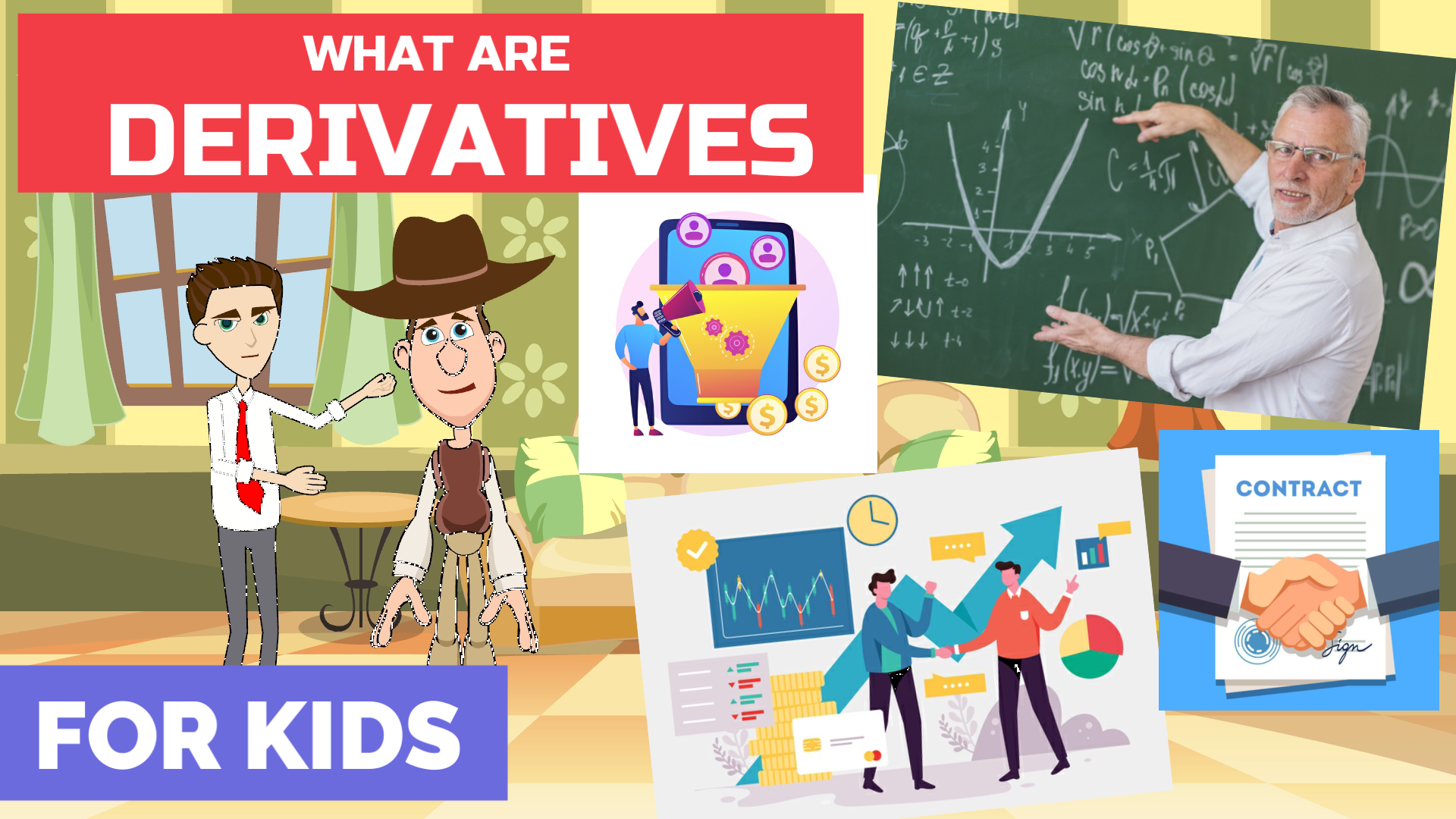Introduction to Derivatives for Kids and Teens
This video explains the concept of derivatives in a simple, concise way for kids and beginners. It could be used by kids & teens to learn about derivatives, or used as a money & personal finance resource by parents and teachers as part of a Financial Literacy course or K-12 curriculum.

Suitable for students from grade levels:
- Kindergarten
- Elementary School
- Middle School
- High School
The topics covered are:
- What are Derivatives
- Different kinds of derivatives
- A real-world example
- Why are they used
- How does derivatives trading work
- Should you invest in derivative instruments

What are derivatives?
Derivatives are complex financial instruments that have value only because they are connected to something else, called the underlying asset. In other words, derivatives derive their value from the underlying instrument which could be stocks, bonds, currencies, interest rates, commodities, etc.
On their own, derivatives have no value. The price of the derivative is determined and influenced by the price of the underlying asset.
Are there different types of derivatives?
Yes, the most common derivatives are futures, forwards, swaps and options.
At a high level, futures, forwards and swaps are binding on the holder of the contract – which means the parties that enter into the agreement must fulfill their obligation. Options, as the name suggests, give the option holder the right, but not the obligation, to buy or sell the underlying instrument.
We cover each derivative instrument in detail in separate videos.
Humm… That’s complicated! Can you explain it with an example?
Let’s say Ben, a corn farmer, is worried that the price of corn will go down by the time his crop is ready for harvesting and wants to lock in the sale price at the current market price.
On the other hand, Sam, a popcorn manufacturer, thinks that corn prices will go up in a few months and wants to lock his purchase price at the current market price.
In this case, Ben and Sam enter into a forward contract, which is an agreement for Ben to sell and Sam to buy a fixed amount of corn at a future date, say 3 months from now, at today’s price. This way, they both hedged their risk based on their assessment of the future corn price.

Why are derivatives used?
Derivatives were primarily created for hedging risk, like we discussed in the example.
However, derivatives are highly leveraged instruments where the parties can trade by putting up only a small percentage of the trade value upfront, called the margin. This makes them high risk, high reward investments, and are therefore used by risk seekers for speculation.
How does derivatives trading work? And how can I invest in derivatives?
Some Derivatives are traded on exchanges, just like stocks. These can be bought and sold through your regular brokerage account if you have enrolled for derivatives investment.
But most derivatives are traded directly between two parties, usually financial institutions like banks, with the contract terms mutually agreed between the two parties. These are called Over-the-Counter, or OTC derivatives.
Should I invest in derivative instruments?
Derivatives provide leverage, which results in an amplified effect on your returns: both profits and losses can be huge. In order to invest successfully, a deep understanding of the instruments, the markets and the risks involved is a must.
Therefore, derivatives are best left to seasoned investors, and should be avoided by new or inexperienced investors.
Conclusion
What do you think about derivatives? Have you invested in any? Please let us know through your comments below!
Download Transcript: Ideal for Use by Teachers in their Lesson Plan to Teach Kids & Teens
Podcast: What are Derivatives
Fun, informative and concise episodes by a 10-year old, breaking down complex financial concepts in a way that kids and beginners can understand. Episodes cover personal finance topics like saving, investing, banking, credit cards, insurance, real estate, mortgage, retirement planning, 401k, stocks, bonds, income tax, and more, and are in the form of a conversation between a cowboy (a finance novice) and his friend, a stock broker. Making finance your friend, only at Easy Peasy Finance.
A little bit about me: I have been fascinated with the world of personal finance since I was 6! I love to read personal finance books, and keep myself updated on the latest by reading various personal finance magazines. My friends often ask me questions about finance because they find it complex and intimidating. That’s what inspired me to start my YouTube channel called Easy Peasy Finance when I was 8, and this podcast 2 years later.
Everything you need to know about derivatives: What are derivatives, What are the different kinds of derivatives, A real world example and explanation of derivatives, Why are derivatives used, How does derivatives trading work, How can you invest in derivatives, Should you invest in derivatives, and more.
Show notes and transcript at: https://www.easypeasyfinance.com/derivatives-for-kids-teens-beginners/


